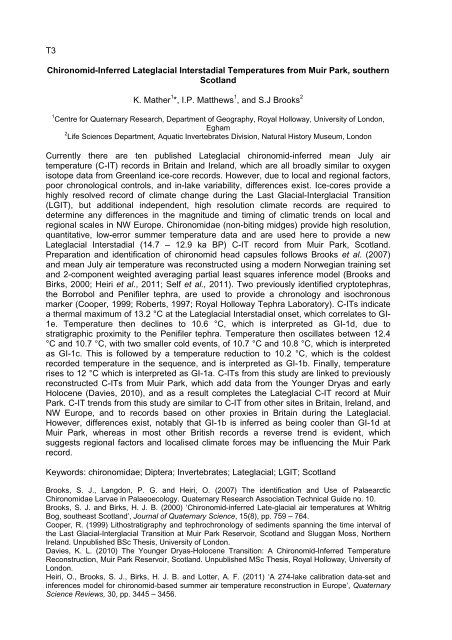The full programme book (PDF) - Royal Geographical Society
The full programme book (PDF) - Royal Geographical Society
The full programme book (PDF) - Royal Geographical Society
You also want an ePaper? Increase the reach of your titles
YUMPU automatically turns print PDFs into web optimized ePapers that Google loves.
T3<br />
Chironomid-Inferred Lateglacial Interstadial Temperatures from Muir Park, southern<br />
Scotland<br />
K. Mather 1 *, I.P. Matthews 1 , and S.J Brooks 2<br />
1 Centre for Quaternary Research, Department of Geography, <strong>Royal</strong> Holloway, University of London,<br />
Egham<br />
2 Life Sciences Department, Aquatic Invertebrates Division, Natural History Museum, London<br />
Currently there are ten published Lateglacial chironomid-inferred mean July air<br />
temperature (C-IT) records in Britain and Ireland, which are all broadly similar to oxygen<br />
isotope data from Greenland ice-core records. However, due to local and regional factors,<br />
poor chronological controls, and in-lake variability, differences exist. Ice-cores provide a<br />
highly resolved record of climate change during the Last Glacial-Interglacial Transition<br />
(LGIT), but additional independent, high resolution climate records are required to<br />
determine any differences in the magnitude and timing of climatic trends on local and<br />
regional scales in NW Europe. Chironomidae (non-biting midges) provide high resolution,<br />
quantitative, low-error summer temperature data and are used here to provide a new<br />
Lateglacial Interstadial (14.7 – 12.9 ka BP) C-IT record from Muir Park, Scotland.<br />
Preparation and identification of chironomid head capsules follows Brooks et al. (2007)<br />
and mean July air temperature was reconstructed using a modern Norwegian training set<br />
and 2-component weighted averaging partial least squares inference model (Brooks and<br />
Birks, 2000; Heiri et al., 2011; Self et al., 2011). Two previously identified cryptotephras,<br />
the Borrobol and Penifiler tephra, are used to provide a chronology and isochronous<br />
marker (Cooper, 1999; Roberts, 1997; <strong>Royal</strong> Holloway Tephra Laboratory). C-ITs indicate<br />
a thermal maximum of 13.2 °C at the Lateglacial Interstadial onset, which correlates to GI-<br />
1e. Temperature then declines to 10.6 °C, which is interpreted as GI-1d, due to<br />
stratigraphic proximity to the Penifiler tephra. Temperature then oscillates between 12.4<br />
°C and 10.7 °C, with two smaller cold events, of 10.7 °C and 10.8 °C, which is interpreted<br />
as GI-1c. This is followed by a temperature reduction to 10.2 °C, which is the coldest<br />
recorded temperature in the sequence, and is interpreted as GI-1b. Finally, temperature<br />
rises to 12 °C which is interpreted as GI-1a. C-ITs from this study are linked to previously<br />
reconstructed C-ITs from Muir Park, which add data from the Younger Dryas and early<br />
Holocene (Davies, 2010), and as a result completes the Lateglacial C-IT record at Muir<br />
Park. C-IT trends from this study are similar to C-IT from other sites in Britain, Ireland, and<br />
NW Europe, and to records based on other proxies in Britain during the Lateglacial.<br />
However, differences exist, notably that GI-1b is inferred as being cooler than GI-1d at<br />
Muir Park, whereas in most other British records a reverse trend is evident, which<br />
suggests regional factors and localised climate forces may be influencing the Muir Park<br />
record.<br />
Keywords: chironomidae; Diptera; Invertebrates; Lateglacial; LGIT; Scotland<br />
Brooks, S. J., Langdon, P. G. and Heiri, O. (2007) <strong>The</strong> identification and Use of Palaearctic<br />
Chironomidae Larvae in Palaeoecology. Quaternary Research Association Technical Guide no. 10.<br />
Brooks, S. J. and Birks, H. J. B. (2000) ‘Chironomid-inferred Late-glacial air temperatures at Whitrig<br />
Bog, southeast Scotland’, Journal of Quaternary Science, 15(8), pp. 759 – 764.<br />
Cooper, R. (1999) Lithostratigraphy and tephrochronology of sediments spanning the time interval of<br />
the Last Glacial-Interglacial Transition at Muir Park Reservoir, Scotland and Sluggan Moss, Northern<br />
Ireland. Unpublished BSc <strong>The</strong>sis, University of London.<br />
Davies, K. L. (2010) <strong>The</strong> Younger Dryas-Holocene Transition: A Chironomid-Inferred Temperature<br />
Reconstruction, Muir Park Reservoir, Scotland. Unpublished MSc <strong>The</strong>sis, <strong>Royal</strong> Holloway, University of<br />
London.<br />
Heiri, O., Brooks, S. J., Birks, H. J. B. and Lotter, A. F. (2011) ‘A 274-lake calibration data-set and<br />
inferences model for chironomid-based summer air temperature reconstruction in Europe’, Quaternary<br />
Science Reviews, 30, pp. 3445 – 3456.
















